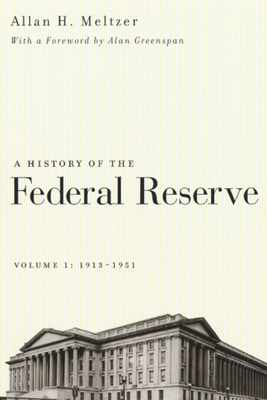A History of the Federal Reserve, Volume 1: 1913-1951
Allan H. Meltzer

My rating in no way suggests that I think people besides me would enjoy reading this book. But I’m very glad that I did, and looking forward to reading Volume 2.
I have a funny relationship with this book. On the one hand, I often found it a tough slog to get through. Not only is it 750 pages long, but Meltzer is in some ways the anti-Michael Lewis: he takes a story that is rife with international intrigue and personal conflicts, and makes it about as dry as possible. Meltzer revels in statistics and in quotations from memos that he dug up in the Fed archives, but makes very little effort toward crafting the history into a narrative or giving any sense of the characters of the key players. Were it not for the fact that this book was my companion on two eight-hour-long flights, it’s quite possible that I wouldn’t have finished it. But on the other hand, I find myself thinking about it a lot.
As someone with an interest in economics and who works at the Federal Reserve, I found a lot of interesting history in this book. I will try not to get too deep into it here, but here are some of the things in broad strokes:
-The speed with which the American economy transformed from being essentially regional to essentially national. This transition certainly happened within the span of time covered in this book (1917-1951), and probably in a significantly shorter time. It was amazing to me how independent the Reserve Banks were in the early years of the Fed, with the Board in DC playing almost no role. In the early years, for example, the different Reserve Banks set their own discount rates, and that was basically unproblematic. But over the course of this book you see that independence unravel, as an increasingly national financial system starts arbitraging away differences and essentially forcing the U.S. to adopt a real central bank, which many people had not wanted.
-The bizarro logic of a gold standard system. I am obviously someone whose entire academic and professional career in economics has occurred under a pure fiat currency system. It is second nature for me to think of monetary policy as countercyclical, “taking away the punch bowl” as the traditional phrase has it. I was familiar with the evidence, from Bernanke and others, that countries that left the gold standard earlier following the Great Depression tended to recover better. But still, it’s so strange to observe the historical Fed following “gold standard rules” that lead it to take exactly the wrong steps, from the perspective of national economic well-being, simply to try to maintain arbitrarily decreed parity rates with gold and with other currencies. Anyone who thinks it would be better for us to go back to the gold standard should read this book.
-The significance of clear goals for policy-making. The Fed’s “dual mandate” to maintain maximum employment and price stability only dates back to 1977. Before that time (i.e. during the whole period covered by this book and then some), the objectives of the Fed were basically unclear. So in a sense, it is no wonder that the Fed failed to implement expansionary policy during the Great Depression, or that it kowtowed to the Treasury in pegging interest rates between WWII and the Fed-Treasury Accord (1951, where this book ends). It is amazing how many times in the course of this book Fed policymakers are unable to agree on actions, not just because they disagree on the best way to achieve their objectives (as is still the case today), but because they disagree on what the objectives are, or don’t even have a clear opinion on that themselves.
-The importance of a measure of humility in economic policy-making. It is very tempting to read this book from a teleological perspective, wherein the Fed groped its way around for decades until it finally grasped the “right” way of being a central bank (i.e. what we have now). I think it is undeniable that the institution has made many steps in the right direction. As just one example, it is almost unbelievable how many policy errors recounted in this book stemmed from the failure of the Fed to distinguish between nominal and real (inflation-adjusted) interest rates, something that every Econ 101 student learns today. But at the same time, this book also hammers home how these past policymakers were generally smart, informed, and well-meaning, and yet believed strongly in doctrines that now seem very misguided. I think we would be wise to try to see ourselves in the same light that we see these historical characters.
There is a strain of economic thinking that I find interesting, which I mostly associate with Ashwin Parameswaran at the blog Macroeconomic Resilience, that looks at the economy from an ecological perspective, where selection pressures operate on the strategies adopted by various economic actors. Ashwin writes about how government stabilization of the economy encourages firms to pursue “exploitative” rather than “exploratory” innovation–that is, to pursue strategies of getting more efficient at doing “the same old thing” rather than to explore new possibilities. The economic environment depicted in this book is certainly not one of policy-generated stability–as I mentioned earlier, even Fed insiders didn’t agree on what they should be doing, and as a result, swings in production and inflation were much sharper than during the Great Moderation period from the mid-80s to 2007. And it was indeed a period where a great deal of exploratory innovation occurred. But even acknowledging the force of Ashwin’s argument, it seems difficult to me to argue that the “policy” pursued in this history is somehow preferable to policy in the Great Moderation era (even if the 2008 crash is pretty strong prima facie evidence against the latter). Perhaps this is just the unwillingness of a technocrat to disavow technocracy.